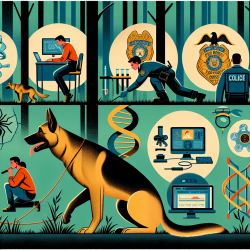In the realm of forensic science, the use of mantrailing dogs has proven to be a valuable asset for law enforcement agencies. These specially trained dogs possess an extraordinary ability to follow human scent trails, making them indispensable in solving crimes. A recent research article titled "The use of mantrailing dogs in police and judicial context, future directions, limits and possibilities – A law review" provides a comprehensive overview of the capabilities, limitations, and potential future applications of mantrailing dogs in forensic investigations. This blog will delve into the key findings of the research and offer practical insights for practitioners looking to enhance their skills or pursue further research in this field.
The Capabilities of Mantrailing Dogs
The research highlights the exceptional sensitivity of the canine nose, which allows mantrailing dogs to detect and follow human scent trails over long distances and varied terrains. These dogs are trained to recognize and discriminate between different human scents, making them effective in locating missing persons or tracking suspects. The study also emphasizes the importance of rigorous training and certification for both the dogs and their handlers to ensure reliability and accuracy in real-world deployments.
Admissibility of Mantrailing Evidence in Court
One of the critical aspects discussed in the research is the admissibility of mantrailing evidence in court. The study provides an overview of the legal frameworks in Germany, France, and the USA, highlighting the differences and similarities in how mantrailing evidence is treated. In Germany and the USA, mantrailing evidence is admissible but often serves as supporting evidence rather than sole proof. In France, while mantrailing results are documented in technical reports, they do not hold probative value in court.
Best Practices for Practitioners
For practitioners looking to improve their skills or incorporate mantrailing into their investigative toolkit, the research offers several best practices:
- Rigorous Training: Ensure that both the dog and handler undergo comprehensive training and certification to meet the required standards.
- Documentation: Meticulously document the collection of scent samples and the entire mantrailing process, including video recordings, to maintain transparency and credibility.
- Use of Certified Dogs: Only deploy dogs that have successfully completed relevant examination levels and are certified for mantrailing tasks.
- Independent Verification: Utilize multiple dogs to independently verify the results, ensuring objectivity and reducing the risk of false positives.
Future Directions and Research Opportunities
The research identifies several areas for future exploration, including the development of standardized training protocols, the investigation of scent trail longevity, and the identification of specific scent components used by dogs. Practitioners are encouraged to contribute to this growing body of knowledge by conducting further research and sharing their findings with the forensic science community.
To read the original research paper, please follow this link: The use of mantrailing dogs in police and judicial context, future directions, limits and possibilities – A law review.










